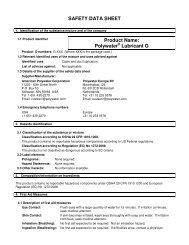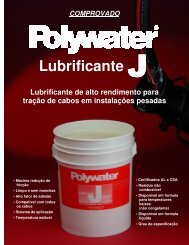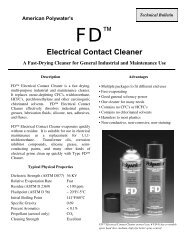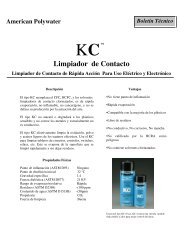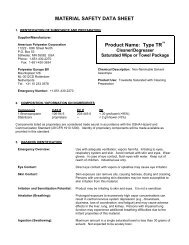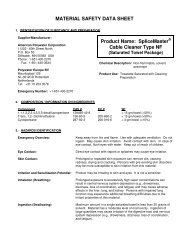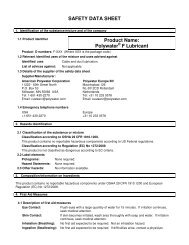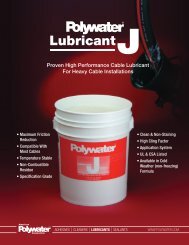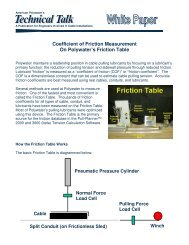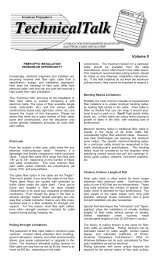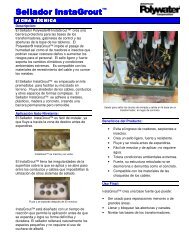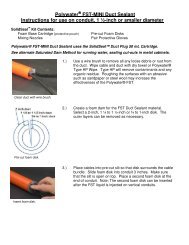PDF Format - American Polywater
PDF Format - American Polywater
PDF Format - American Polywater
Create successful ePaper yourself
Turn your PDF publications into a flip-book with our unique Google optimized e-Paper software.
Volume 12-2<br />
Premises Versus Outside Plant Cable Pulling<br />
As communication and data networks are installed<br />
in harsh industrial environments, more and more<br />
lightweight cable (fiber optic, shielded copper,<br />
coaxial, or hybrid) is being placed in conduit for<br />
protection. When such cable is pulled into conduit,<br />
there are significant differences from the<br />
installation of its "outside plant" counterpart. This<br />
TeleTopics will review these differences. While the<br />
data presented is for premises fiber optic cable,<br />
the principles apply to most lightweight cable.<br />
Maximum Tension<br />
Indoor cables are much smaller and lighter in<br />
weight than outdoor cables. This light weight<br />
makes them easy to handle and install. However,<br />
the tensile strength and maximum pulling tension<br />
for premises cables is much lower than for outdoor<br />
cable.<br />
A tension maximum for a cable is usually<br />
expressed in units of lbs force (lbf) or Newtons<br />
(N). The Newton is a metric measure of force<br />
equal to 10 5 dynes or 4.45 lbf. To convert a Newton<br />
force to a pound force, divide it by 4.45. For<br />
example, a maximum pulling tension of 100<br />
Newtons converts to 22.5 lbf.<br />
Six hundred lbf (2700 N) is a typical maximum<br />
tension for outside plant fiber optic cable. Tensions<br />
for premises cable depend on cable construction.<br />
Tensions for fiber optic premises cable can be as<br />
low as 25 lbf (110 N), and are often lower than 100<br />
lbf (440 N). An installer can easily exert 25 lbs of<br />
force (110 N) with a single arm. Attention and care<br />
are clearly needed to respect the tension limits of<br />
indoor cable.<br />
Pulling Bundled Cables<br />
The pulling of multiple cables into a single conduit<br />
is much more common in building environments<br />
than in outside plant construction. If we know the<br />
maximum tension allowable on a single cable,<br />
what is a safe maximum tension for a "bundle" of<br />
the cables The question is how many and which<br />
cables are supporting the pulling load in a bundle of<br />
cables<br />
There is some precedent for maximum bundle<br />
tension from electrical control cable installation,<br />
where the total of the tensile strengths for all<br />
cables is lowered by 20% to 50%, depending on<br />
specifics. Consult with the cable’s manufacturer<br />
for their recommendations on maximum tension<br />
for single and multiple cable pulls.<br />
Cable Jacket<br />
Carbon black loaded polyethylene (HDPE, MDPE)<br />
is the predominant outside plant cable jacket.<br />
Indoor cables, on the other hand, are often color<br />
coded (orange, yellow, or white). The jackets tend<br />
to be fire resistant materials such as PVC, PTFE,<br />
and PVDF. Because of these jacket differences,<br />
the pulling properties and friction character of<br />
indoor cable is very different from outdoor cable.<br />
Conduit/Lubricant Viscosity<br />
When outside plant cables are pulled, the conduit<br />
systems are usually underground. The duct is<br />
often continuous HDPE (innerduct), PVC, or multicell<br />
type. Pourable lubricants, like <strong>Polywater</strong>® F or<br />
Network Loop Lube with Silicone are used. It's<br />
fast and convenient to pour the pulling lubricant into<br />
the cable feeder tube or upturned duct before you<br />
start the pull and as needed throughout the pull.<br />
The conduit in an indoor system may be steel,<br />
PVC, or one of the newer continuous tube<br />
“premises” ducts. Regardless, the type of pulling<br />
and lubricant application method is different from<br />
an outside plant pull. It is common in industrial<br />
pulling for conduit (and the cable pull) to go up<br />
walls and across ceilings. Cable feeding is often<br />
overhead and on cables going up. Liquid lubricants<br />
are simply not practical to apply. Strong gel<br />
lubricants are needed, like Premise Loop<br />
Lubricant, which clings to the cable and doesn't<br />
back flow.<br />
Tension Reduction<br />
With everything else equal (cable weight, conduit<br />
layout, etc.), the best way to lower cable pulling
tension is to reduce the friction of the cable jacket<br />
against the conduit wall. Friction is measured by a<br />
dimensionless constant called coefficient of friction<br />
(COF) or friction coefficient. Studies have shown<br />
that friction coefficient varies with cable jacket type,<br />
conduit type, temperature, and pulling lubricant<br />
type.<br />
The data below are friction coefficients for<br />
"premises" fiber cable in “premises” duct from a<br />
“multi-bend” pulling test. This test controls the<br />
input (back) tension on a cable and measures the<br />
pulling tension through a series of conduit bends.<br />
From these measurements, a coefficient of friction<br />
can be determined. See TeleTopics Volume X for a<br />
more detailed theoretical discussion of this<br />
method.<br />
The tests involved a number of distribution cables<br />
and pulling lubricants. There is too much data to<br />
present here. The graph below is representative. It<br />
plots the calculated COF (coefficient of friction)<br />
against the incoming (back) tension.<br />
Coefficent of Friction<br />
0.4<br />
0.35<br />
0.3<br />
0.25<br />
0.2<br />
0.15<br />
0.1<br />
0.05<br />
0<br />
Unlubricated<br />
0 5 10 15<br />
Incoming Tension (lbf)<br />
The graph shows the cable has an unlubricated<br />
COF in this duct of 0.33 to 0.36. <strong>American</strong><br />
<strong>Polywater</strong>'s Premise Loop Lube (a gel) lowers<br />
the friction coefficient more than the common<br />
"outside plant" (liquid) lube. The Premise Loop<br />
Lube was designed to work with the jackets and<br />
conduits typical of indoor cables. For more<br />
information, view the Premise Loop Lubricant<br />
flyer on-line at<br />
http://www.polywater.com/premise.html .<br />
Both lubricants significantly lower the friction<br />
coefficient compared to the unlubricated, and thus<br />
will reduce the pulling forces needed to install the<br />
cable. But how much<br />
Relating Friction to Tension<br />
OSP Lube<br />
Premises Loop Lube<br />
How can we know what a reduced friction<br />
coefficient means in any specific cable installation<br />
Can we make the pull with less than the cable’s<br />
maximum load Can we safely pull farther and<br />
thus save money<br />
The cable pulling equations relate friction<br />
coefficient to cable pulling tension. A simplified<br />
form of the equations will clarify:<br />
Straight Conduit<br />
T out = T in + LWµ<br />
Conduit Bend T out = T in e µθ<br />
Where:<br />
T out<br />
T in<br />
L<br />
W<br />
= Tension Out<br />
= Tension In<br />
= Length of Straight Run<br />
= Weight of Cable (per length)<br />
µ = Coefficient of Friction<br />
θ = Angle of Bend<br />
e = Natural Log Base<br />
Note how significant the friction coefficient (µ) is in<br />
determining tension. In bends, the friction<br />
coefficient is in an exponent that multiplies the<br />
incoming tension. In pulls with a few bends, COF<br />
reduction of 50 to 65% (as seen in the graph) can<br />
reduce pulling tension by factors of 5 to 10!!<br />
Pull-Planner 2000 Software<br />
The actual pulling equations are considerably more<br />
complex than the simplified forms shown above.<br />
<strong>American</strong> <strong>Polywater</strong>’s Pull-Planner 2000<br />
Software allows easy estimation of pulling tensions<br />
on a PC. It enables “what if” scenarios with cable,<br />
conduit, pull length, COF, incoming tension, and<br />
more. The software has an internal database with<br />
measured friction coefficients for many jacket and<br />
conduit types.<br />
A preview of the Pull-Planner 2000 for<br />
Windows is available on our web page at<br />
http://www.polywater.com/preview.html.<br />
Summary<br />
Unnecessary high tension can damage cable,<br />
costing both time and money. The use of high<br />
performance pulling lubricants and the science of<br />
tension estimation can help prevent cable damage<br />
during installation. However, the lubricants that<br />
served so well for the pulling of polyethylene<br />
jacketed outside plant cable are not as effective on<br />
indoor cables. A special product, Premise Loop<br />
Lubricant, which was developed for this type of<br />
cable, provides outstanding friction reduction.<br />
Additional information on this or other <strong>American</strong><br />
<strong>Polywater</strong> products is available on the web page or<br />
by calling or writing to the address below.<br />
TeleTopics Editor<br />
P.O. Box 53<br />
Stillwater, MN 55082<br />
USA<br />
Phone:1-(651)-430-2270 Toll Free:1-(800)-328-9384<br />
Fax:1-(651)-430-3634 E-Mail:tteditor@polywater.com



